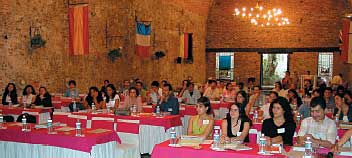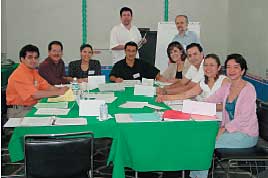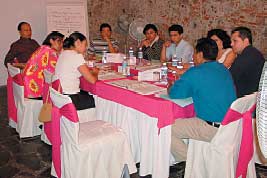 |
||
| Massachusetts Institute of Technology |
|
Integrated Program on Molina Center for Energy and the Environment Voice: (858) 657 Fax: (858) 657- E-mail: info@mce2.org |
Reports from the Mid-Career WorkshopJed HorneHotel Vista Hermosa, Tequesquitengo, Mexico. August in Tequesquitengo can be a scorcher, and the clear blue of the swimming pool at this Conquista-era resort looked mighty inviting. Despite a few furtive glances, however, the participants at the second workshop for mid-career professionals, organized jointly by the Comisión Metropolitana del Medioambiente (CAM) and the Massachusetts Institute of Technology (MIT), resisted temptation and quickly got down to brass tacks. The students, coming from universities, government, environmental NGOs, and industry, were here to learn. The Hotel Vista Hermosa’s ample and luxurious amenities were of secondary importance.
The week’s schedule was divided into two three-day workshops, given by world-class educators in their respective fields. Dr. John Evans, of the Harvard Center for Risk Analysis, began the week with a discussion of risk analysis – a tool for communicating scientific investigations to concerned stakeholders. Dr. Larry Susskind, from the Department of Urban Studies and Planning at MIT, emceed a highly interactive forum on negotiation and conflict resolution – a key component of environmental decision-making, and an area that often draws on risk assessment analysis. Bleary eyed and still stuffed from the welcome dinner on Sunday night, the participants filed into the hotel’s majestic conference room at 8:30 on Monday morning, eager and prepared for the week ahead. Introduction to Risk Assessment (August 12-14)
After brief introductory remarks, Dr. Mario Molina introduced Professor Evans, who began his presentation by asking three focal questions: What is risk? Can it be studied? And, if it can, how do we use existing evidence to evaluate it? Noting the diverse background of the workshop’s 60-odd participants, Dr. Evans asked them how they would define the “ideal” background for risk assessment. Everyone quickly realized that risk assessment, like the broader problem of air pollution, is truly a multidisciplinary endeavor, one that requires the expertise of chemists, doctors, statisticians, and epidemiologists – fortunately, groups well represented in this extraordinary gathering of people. Risk assessment, Dr. Evans argued, is an important tool for communicating between these disciplines, streamlining research goals, and facilitating decision making among concerned parties. Of particular relevance to the organizations represented in the room, risk assessment can aid decision making in air-pollution management, adding credibility and breadth to cost-benefit analyses that otherwise might lack political backing. Risk assessment also provides a framework to evaluate what assumptions were made behind a particular decision. It is often these assumptions, rather than hard science, that guide policymaking. There are four stages of risk assessment in public health: hazard identification, exposure assessment, dose-response assessment, and risk characterization. Again, it is often how hazards are labeled, rather than the actual risk they represent, that guides much of the public reaction to that hazard, and, in turn, the policy responses to it. Dr. Evans continued the workshop by describing the differences between cancer and non-cancer risk assessment. Cancer risk assessment generally assumes a linear relationship between dose and risk. Non-cancer assessment uses a threshold-type dose response curve. Non-cancer risk assessors compute what is known as the NOAEL (no observed adverse effect level) or the LOAEL (lowest observed adverse effect level). These numbers give an indication of a minimum threshold exposure to certain pollutants or toxins, and are used to computer the reference dose (RfD), a value used in policy making to denote maximum accepted values of that chemical. The workshop continued with a thorough and technical discussion of both cancer and non-caner assessment, including methods for low-dose and inter-species extrapolation for bioassays. Epidemiological evidence was also analyzed, and participants learned about the famous “six cities” study showing a relationship between mortality and air pollution in the United States.
Following Dr. Evans’ introduction to the topic, Paulina Serrano, a doctoral student under his supervision, presented her research on volatile organic compound (VOC) risk assessment in Mexico City. During the course of her research, she collected data from twelve different sites around the city. Her presentation generated considerable interest, and a little controversy – not surprising given the expertise of the workshop’s participants and the immediacy of Mrs. Serrano’s research to the problem at hand. Mrs. Serrano also discussed her research on exposure assessment in the city, again, an area of controversy. The possibility that indoor air pollution is a primary source of exposure to VOCs was raised, questioning some of the assumptions of air pollution control and challenging decision makers to look at microenvironment pollution controls Roberto Muñoz, a researcher in Mexico, also presented the work he had done in the area of public health and estimation of health impacts. The relevance of his specific topic and the controversial nature of his area of research generated methodological and theoretical discussions about valuation, costing, and social perception of control strategies. Dr. Evans concluded his course by presenting his work in value of information analysis. While it is always true that better information will lead to better decision making, it is often the case that the cost of obtaining that information and the requisite delay in decision making may outweigh any benefits to acquiring it. Depending on the discount rate, for example, a delay in enacting restrictions on fine particle emissions, created by overly-cautious environmental policy, may hurt society rather than help it. Value of information analysis is an important tool for establishing research priorities. Negotiation and Conflict Resolution (August 15-17)
On Thursday, Professor Mario Molina was called upon again for an introduction. Dr. Susskind, the Ford Professor of Urban and Environmental Planning at MIT and president of the multi-national consulting firm Consensus Building Inc., was joined by Dr. Basilio Verduzco Chávez, a Professor in the Department of Regional Studies at the University of Guadalajara. Professor Susskind began by emphasizing the increasing importance of negotiation and conflict resolution, particularly in contentious disputes where the courts can become involved in the absence of an amicable solution. Dr. Verduzco drew on his immediate experience in Mexico, and commented on the rapidly changing political climate in the country. With the emergence of a three-party democratic system, it is now almost impossible to impose a decision without conflict, and negotiation is an increasingly important tool used by policy makers and politicians to iron out their differences. The main emphasis of the next three days was three negotiation games, simulating environmental disputes and introducing important concepts in conflict resolution. In the first simulation, two fictitious countries, Alba and Batia, competed by selling oil to a third, richer country, Capita. Participants were divided into twelve groups, split evenly between Alba and Batia. The groups were paired, and each pair of two countries set prices for what they thought would be maximum benefit given imperfect information about how the other group was making the same decision. After a few rounds, the warring parties were allowed to meet and to negotiate fixed prices for maximum benefit. Of course, many of the agreements were not perfect. Miscommunication, betrayal, and cutthroat decision-making tainted a few of the negotiation groups, often dragging down the gains of both parties involved. The conclusion was reached that the three most important characteristics of a successful negotiator in the first game were provocability, forgiveness, and clarity. It is important to punish betrayal or departure from agreements, but it is equally important to forgive sincere retractions of mistakes. A muddled or ambiguous strategy simply leaves the other team at a loss, making agreement nearly impossible. Dr. Susskind then described a “mutual gains” approach to decision making – a four step process. The first, and perhaps most important step, is preparation. The second step is to create value by, before the division of benefits has even been discussed, creating a “larger pie” to compete for. The third step is to distribute the value generated during the second step. The final step, often ignored by decision makers, is follow through and enforcement. Competing parties are looking at the bottom line – what is
their best alternative to no negotiation (BATNA)? Here the most
important question to ask is “what if?” – with
a little imagination, the players will often realize they have more
to offer each other than they first realized, probably considerably
more than their respective BATNA’s. The three aspects of good
negotiation – forgiveness, clarity, and provocability, still
apply. It is also necessary to be prepared for any unexpected events
or surprises that may occur during the negotiation itself or during
the final implementation. In the Pablo Burford simulation, participants were divided into groups of ten. Players were assigned roles as representatives of different government agencies, NGOs, and lobby groups. Together, they were charged with ironing out environmental disputes between a developing country, Pablo, and its developed neighbor, Burford. Participants reported favorable reactions to the game, and appeared to have learned quite a bit by the earlier games and theoretical discussions. Dong-Young Kim, a Ph.D. candidate under Dr. Susskind’s supervision, was pleased with the results. "Because I was in charge of filming the workshop, I kept a close eye on the participants. Even with the sizzling heat and long schedules, I didn’t catch anybody napping. People took the Pablo-Burford game so seriously they didn’t even talk over the enchiladas at lunch," he noted. Dr. Susskind was equally impressed. He commented afterward, “The participants seemed totally dedicated to the work at hand. They committed themselves to often unfamiliar assigned roles and played their parts with skill and passion. I think the skills of negotiation taught in the seminar will be of great importance to many of the participants in their professional roles.” On Sunday, August 18th, the participants had to leave their role as students and return to their real jobs as engineers, lawyers, scientists, and government officials. The conference had been an overwhelming success, and everyone seemed in a good mood on the way out. Maybe it was everything they had learned, but it could have been that a few of the participants had done more than glance at the pool – only in the evenings, of course. Armed with new tools, everyone involved left the serenity of Vista Hermosa better prepared for the considerable challenges ahead. Special thanks to Professor Gerardo Mejia for ITESM, Professor Larry Susskind of MIT, and Dong-Young Kim for providing information for this article. |




